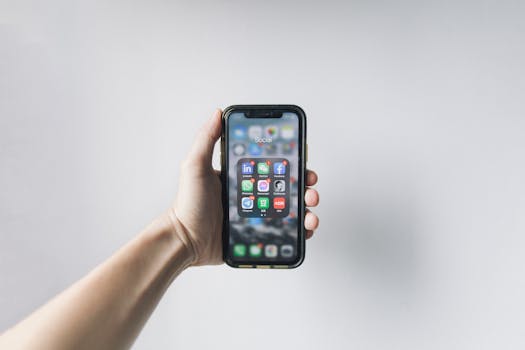Tutorials
Turn on Dark Mode: Comfort and Style for Your Apps
Find out how to enable dark mode in popular apps and enjoy the benefits of this modern setting that saves battery and reduces eye strain.
Advertisement
Technology is advancing rapidly, offering new ways for users to personalize and enhance their experience. A growing trend is the use of dark mode in apps. This setting not only provides a sleek look but also helps reduce eye strain and saves battery life, especially on devices with OLED displays. In this article, we'll learn how to enable dark mode in supported apps.
With the popularity of dark mode, many apps have started adopting this feature. Microsoft, Apple, and Google are among the companies that have incorporated this option into their operating systems. Dark mode is especially popular among those who spend long hours using electronic devices. Therefore, understanding how to activate it can provide a more enjoyable experience.
Enabling dark mode is a simple process that varies by app and operating system. Most modern apps offer the option to toggle dark mode in the settings. Let's explore the steps to enable this feature on different platforms and apps.
What is Dark Mode?
Dark mode is a setting that changes the traditional white background to a black or dark background. This change helps reduce blue light emissions. Additionally, reducing brightness helps reduce long-term eye strain.
Another advantage of dark mode is battery savings. On AMOLED and OLED screens, every black pixel is turned off, consuming less power. This feature can significantly increase battery life.
Using dark mode also has a positive effect on the aesthetics of apps. Many users prefer the softer, more modern look provided by the dark theme. Choosing dark mode, therefore, becomes a matter of style and comfort.
Additionally, dark mode can improve visibility in low-light environments. When using a device in a dark room, for example, the bright light from a bright screen can be uncomfortable. Dark mode solves this problem.
Overall, dark mode brings benefits both in terms of eye health and device energy efficiency. Throughout this article, you'll learn how to enable it in various apps.
How to Enable Dark Mode on Android
Enabling dark mode on Android devices may vary depending on the operating system version. However, the basic process is similar for most modern versions.
The first step is to open your device's settings. Within the settings, look for the "Screen" or "Display" option. Within this section, you'll find the option to enable dark mode.
In addition to system settings, many apps available on the Play Store offer dark mode functionality. This means that even if your Android is in light mode, you can enable them individually.
In some cases, there's an option to automatically activate dark mode. This option is perfect for those who want the theme to change with the environment, such as at dusk.
After activating this, you'll notice that both the system and compatible apps will now display dark mode. It's a simple and effective change.
How to Enable Dark Mode on iOS
For iPhone users, the process of enabling dark mode is also quite simple. Start by accessing the "Settings" menu on your device.
In the Settings section, tap "Display & Brightness." Here, you'll find an option to toggle between light and dark mode.
Once you select dark mode, all supported apps automatically switch to that theme. This includes native apps like Messages and Notes.
Additionally, iOS allows you to schedule Dark Mode to turn on and off at specific times. This feature is useful for maintaining a comfortable experience during nighttime use.
Another important tip is to check if the apps you use frequently support dark mode. To do this, visit the app store and check for updates if necessary.
Enabling Dark Mode in Popular Apps
Several popular apps support dark mode. Let's explore how to enable this setting on some of them, such as WhatsApp, Instagram, and Facebook.
To enable dark mode on WhatsApp, go to the app's settings. Tap "Theme" and select "Dark." The app will immediately change to this look.
On Instagram, you can enable dark mode directly in your device's settings. If your system is in dark mode, Instagram will automatically adjust.
Facebook also has an option to enable dark mode in the app's settings. Go to the settings menu and look for the "Theme" option. Select "Dark" to apply the change.
In short, enabling dark mode in apps is a quick and simple process. These customization options make the experience more enjoyable and tailored to user preferences.
Benefits of Dark Mode
Dark mode offers a range of benefits beyond aesthetics. Reducing blue light exposure is essential for eye health. This reduces fatigue caused by long periods of screen time.
Battery life is another significant benefit. For users of devices with OLED displays, dark mode can extend battery life, improving the user experience throughout the day.
Dark mode can reduce glare in dark environments, providing a more comfortable user experience. This is especially useful for reading or browsing at night.
Additionally, using dark mode can help increase focus. A dark background can make content more visible and reduce visual distractions.
Finally, dark mode contributes to a modern and elegant aesthetic. Many users prefer the look and feel of this theme, making interaction more enjoyable.
Possible Disadvantages of Dark Mode
While dark mode has a number of benefits, there are some drawbacks to consider. One of the main ones is text readability under certain conditions.
Some users may find the contrast between light text and a dark background difficult to read. This can be a hindrance for those who spend long periods reading.
Additionally, not all apps are designed for dark mode. In certain cases, such as with images or icons, changing the theme may not be as visually effective.
Image quality can also be affected in some situations. In photo editing apps, for example, color perception can change with a dark background.
Finally, not all users are accustomed to dark mode, so this change may take some time to adapt to, especially for those who prefer light mode.
Conclusion
Enabling dark mode in supported apps is a simple process. This setting not only provides a modern look but also benefits eye health and battery life.
With this functionality's growing popularity, exploring the options available in apps and operating systems is a smart choice. It's a way to personalize your digital experience.
The tips and tricks covered in this article can help anyone navigate this topic, making the user experience more enjoyable and comfortable. Experiment with the recommended settings and see what works best.
Regardless of the operating system, dark mode is available in most apps, reflecting a commitment to modern usability. Take advantage of this trend and adapt your apps.
With these instructions, you can easily transition to dark mode, making your digital use more conscious and comfortable. Get started today!




